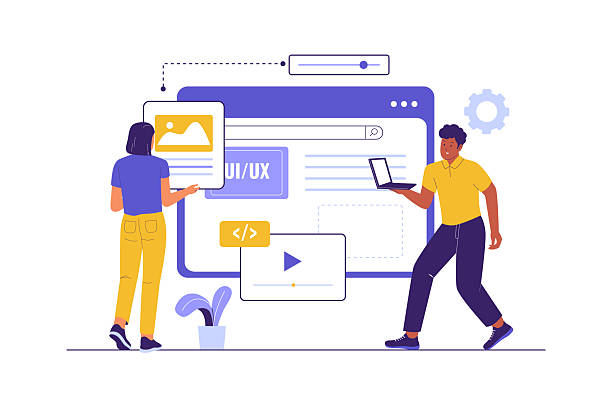Introduction to the Importance of SEO-Optimized Website Design in Today’s World
![]()
In the current digital age, an online presence is vital for every business.
However, merely having a website is not enough; your website must be searchable.
#SEO-optimized_website_design means building a website that is not only attractive and functional for users but also technically understandable and rankable for search engines like Google.
This approach helps you appear higher in search results and attract more organic traffic.
Without an SEO-optimized website design strategy, even the best content may go unnoticed.
This section provides an explanatory and educational overview of this concept.
Many businesses still do not fully grasp the importance of this issue and merely focus on the aesthetic appeal of their website, while its performance in search engines is overlooked.
An SEO-optimized website forms the backbone of your powerful digital presence, enabling you to connect with your target audience.
This applies not only to keywords but also to user experience, loading speed, and your site’s technical structure.
Investing in search engine optimized website design is a smart step for the sustainable growth of your online business.
This approach ensures that your efforts in content creation and service delivery reach the right audience and increase your conversion rate.
Understanding these basic principles is the first step towards achieving success in the competitive world of the web.
Tired of losing customers due to poor e-commerce website design? With Rasaweb, solve this problem forever!
✅ Increase sales and visitor-to-customer conversion rates
✅ Smooth and attractive user experience for your customers⚡ Get Free Consultation
Key SEO Principles in Website Design

#SEO_principles in website design are a set of technical and content actions aimed at improving website visibility in search results.
These principles include optimizing #site_structure, selecting correct keywords, producing quality content, improving loading speed, and website responsiveness (for correct display on various devices).
A website design with an SEO approach requires precise planning from the very beginning.
For example, creating user-friendly URL structures, using appropriate title tags and meta descriptions, and ensuring that your site is easily accessible by search engine crawlers are of high importance.
This section provides specialized and guiding details on these principles.
Paying attention to these technical points in the initial design stages prevents costly revisions in the future.
For instance, choosing a suitable Content Management System (CMS) like WordPress, which supports SEO tools well, can make a significant difference.
Also, creating an XML sitemap and submitting it to Google Search Console helps search engines properly index all your pages.
Considering these principles from the ground up means investing in your site’s long-term success.
A website designed from the beginning with these principles performs much stronger in terms of search engine optimization and achieves higher rankings faster.
Keyword Research and Content Strategy in SEO-Optimized Website Design

#Keyword_Research is the cornerstone of any successful SEO strategy.
This process involves finding phrases that your target audience uses in search engines to find products, services, or information related to your business.
After identifying suitable keywords, the next step is to produce high-quality and relevant content.
This content should not only naturally include keywords but also be valuable, comprehensive, and engaging for users.
An SEO-optimized website design uses these keywords in titles, descriptions, and the main text of pages.
This section provides an educational and analytical approach to this topic.
Your content should be designed to answer users’ questions and meet their needs, which in turn increases user dwell time on the site and reduces the bounce rate.
These factors send positive signals to search engines.
For example, if your keywords are “SEO-optimized website design,” your content should elaborate on how to do this, its benefits, and related tips.
Additionally, using tools like Google Keyword Planner or Ahrefs can help you find keywords with high search volume and suitable competition.
Creating a content calendar that includes the scheduling of articles, blog posts, and other types of content is essential for maintaining consistency and continuous SEO improvement.
Paying attention to the user’s intent behind each search, known as “Search Intent,” helps you produce more accurate and relevant content, leading to greater user satisfaction and, consequently, better rankings.
Key Keyword Research Tools
| Tool Name | Short Description | Usage Type |
|---|---|---|
| Google Keyword Planner | Provides keyword ideas and search volume from Google | Free, for planning Google Ads and SEO campaigns |
| Ahrefs | Deep analysis of keywords, backlinks, and competitors | Paid, comprehensive for professional SEO specialists |
| Semrush | Powerful tool for SEO, keyword research, and competitor analysis | Paid, complete package for digital marketing |
| Ubersuggest | Keyword analysis, content ideas, and backlinks | Limited free version, suitable for beginners |
Technical Aspects of SEO-Optimized Website Design

#Technical_SEO refers to optimizing your website’s technical infrastructure to improve its crawlability and indexability by search engines.
These aspects include site loading speed, #mobile_friendliness (responsiveness), use of HTTPS, optimized URL structure, XML sitemap, robots.txt file, and structured data (Schema Markup).
An SEO-optimized website design should consider these factors from the outset.
For example, slow loading speed can harm user experience and lead to an increased bounce rate, both of which are detrimental to SEO.
Also, since most searches today are conducted via mobile devices, responsive design and mobile optimization are of paramount importance.
This section provides a specialized and guiding deep dive into these aspects.
Ensuring your website uses HTTPS protocol (which is a Google ranking factor) and minimizing 404 errors are essentials.
Using a CDN (Content Delivery Network) to improve loading speed in different geographical regions and optimizing images with proper compression and alt tags all contribute to improving technical SEO.
Search engines look for websites that provide a fast and hassle-free user experience, so any improvement in technical aspects directly leads to a better ranking in search results.
Ignoring these points can render your efforts in other SEO areas ineffective.
Tired of losing customers due to poor e-commerce website design? With Rasaweb, solve this problem forever!
✅ Increase sales and visitor-to-customer conversion rates
✅ Smooth and attractive user experience for your customers⚡ Get Free Consultation
User Experience (UX) and its Role in SEO-Driven Design
![]()
In the past, SEO primarily focused on keywords and backlinks, but today, #User_Experience (UX) plays a very important role in website ranking.
Google seeks to provide the best results to its users, and a website with poor UX, even with excellent content, may not achieve a good ranking.
Factors such as #low_bounce_rate, high dwell time on the site, easy navigation, and attractive visual design all send positive signals to search engines.
An SEO-optimized website design should simultaneously focus on SEO and UX.
This section provides an analytical and explanatory look at the importance of the synergy between these two concepts.
Improving user experience includes intuitive User Interface (UI) design, ease of access to information, website responsiveness across various devices, and high text readability.
For example, using appropriate white space, readable fonts, and logical content structuring with titles and subtitles can enhance the user experience.
Additionally, a simple and unobstructed registration or purchasing process helps reduce cart abandonment rates and increase customer satisfaction.
Websites designed for their users are not only more successful in SEO but ultimately lead to increased conversions (such as sales or registrations).
Google directly monitors user experience through metrics like Core Web Vitals.
Therefore, neglecting UX in the SEO-optimized website design process means overlooking one of the most important ranking factors in the current era.
Quality Content Production and its Role in SEO

#Quality_Content_Production is the beating heart of any successful SEO strategy.
Search engines aim to provide the most relevant and authoritative content to their users.
Your content must be comprehensive, accurate, unique, and valuable, and it should be regularly updated.
This includes blog articles, service pages, product descriptions, videos, and infographics.
An SEO-optimized website design ensures that the produced content is displayed in the best possible way and is crawlable and understandable for search engines.
This section provides specialized and educational insights into the importance and strategies for creating valuable content.
Adherence to the E-A-T principle (Expertise, Authoritativeness, Trustworthiness) is of paramount importance.
Content written by experts, supported by credible sources, and presented clearly and honestly will be favored by Google.
Using keywords naturally within the text, without unnecessary stuffing, is crucial to avoid search engine penalties.
Additionally, longer and more comprehensive content typically ranks better, as it indicates that you have thoroughly addressed a topic.
Creating attractive visual content and sharing it on social media can also help increase viewership and natural backlinks.
In summary, content is king, and an SEO-optimized website design must provide a suitable platform for its reign.
Without strong and relevant content, even the best technical optimizations cannot guarantee long-term success.
Measuring and Analyzing Website SEO Performance

#SEO_analysis and performance measurement are integral parts of the SEO-optimized website design process.
To ensure your SEO efforts are effective, you must regularly monitor and analyze data.
Tools like Google Analytics and Google Search Console provide vital information about site traffic, keywords, bounce rate, dwell time, and site errors.
This data helps you identify the strengths and weaknesses of your SEO strategy and make informed decisions to improve performance.
This section provides an analytical and guiding overview of important tools and metrics in this area.
Tracking metrics such as keyword rankings, organic traffic, conversion rate, and page views gives you a comprehensive view of your site’s SEO status.
For instance, if you notice that a particular page has a high bounce rate, you can review its content or design to improve the user experience.
Also, monitoring backlinks and identifying harmful or low-quality links can help maintain your site’s credibility.
Regular reporting and trend analysis allow you to react to changes in Google’s algorithms and keep your strategy up to date.
An SEO-optimized website design without continuous monitoring and analysis is like driving without a map; you might get somewhere, but not to your intended destination.
Therefore, using these tools for continuous improvement and achieving SEO goals is essential.
Important Metrics in SEO Analysis
| Metric | Description | Importance for SEO |
|---|---|---|
| Organic Traffic | Number of visitors from search engines | Indicates the overall success of the SEO strategy |
| Bounce Rate | Percentage of visitors who view only one page | Indicates user experience quality and content relevance |
| Average Time on Page | Duration a user spends on a page | Indicates the content’s attractiveness and usefulness |
| Keyword Ranking | Site’s position for specific keywords in search results | Measures the effectiveness of keyword research |
Common Mistakes in SEO-Optimized Website Design and Ways to Avoid Them

Even with the best intentions, mistakes can occur in the SEO-optimized website design process that can harm your site’s ranking.
#Common_SEO_mistakes include keyword stuffing, poor-quality link building (bad backlinks), neglecting site loading speed, lack of mobile responsiveness, and duplicate content.
Avoiding these mistakes requires carefulness and knowledge of best practices.
This section provides guidance and explanation on identifying and resolving these challenges.
For example, one of the most common mistakes is overlooking the internal link structure.
Strong internal linking helps search engines better understand your site’s structure and recognize the importance of different pages.
Also, improper use of heading tags (H1, H2, H3) can confuse search engine crawlers.
On the other hand, attempting to deceive search engines with black-hat SEO techniques like hidden text or cloaking will ultimately result in penalties from Google.
The best approach in SEO-driven website design is to focus on providing real value to users and adhering to Google’s guidelines.
Regularly audit your site, both technically and in terms of content, to prevent these mistakes from occurring.
Investing in educating your design and development team on SEO principles can help prevent these issues from the outset.
Tired of losing business opportunities due to lacking a professional corporate website? Worry no more! With Rasaweb’s corporate website design services:
✅ Your brand’s credibility and professionalism will increase.
✅ You will attract more customers and sales leads.
⚡ Get a free consultation now to get started!
The Future of SEO-Optimized Website Design and New Trends

The world of SEO and SEO-optimized website design is constantly changing and evolving.
With technological advancements and shifting user behavior, new trends emerge that must be considered.
#Future_SEO_trends include optimization for voice search, the growing role of artificial intelligence in Google’s algorithms, the importance of User Experience (UX), especially Core Web Vitals, and a focus on video content.
Websites that adapt to these changes will lead the competition.
This section provides a news-oriented and analytical prediction and examination of these emerging trends.
For example, with the increasing use of voice assistants like Siri and Google Assistant, optimizing for voice search, which usually involves longer and more conversational phrases, becomes especially important.
Furthermore, AI algorithms like Google’s BERT and RankBrain have improved their understanding of natural language, meaning your content should respond more to User Intent than merely containing keywords.
Video marketing is also rapidly growing, and optimizing videos for SEO and placing them on site pages, can help increase engagement and improve rankings.
SEO-optimized website design in the future will focus beyond keywords, on a deep understanding of user behavior and providing an unparalleled user experience.
Being ready for these changes and integrating them into your website design strategy is key to sustained success in the online space.
Long-term Benefits of SEO-Optimized Website Design and Conclusion

Ultimately, investing in SEO-optimized website design not only means improving search engine rankings but also brings many long-term benefits for your business.
#SEO_benefits include increased organic traffic, improved brand credibility, higher conversion rates, and sustainable Return on Investment (ROI).
Unlike paid advertising, which stops when the budget runs out, SEO is a long-term strategy whose results strengthen over time.
This process is an ongoing commitment that requires continuous monitoring, updating, and optimization.
This section provides an engaging and thought-provoking content explanation of these benefits and future outlook.
Did you know that most users look for information on the first page of Google results, and if your website isn’t there, you lose a large portion of potential customers? An SEO-optimized website design allows you to consistently be visible to your target users and attract high-quality traffic without paying per click.
This not only helps reduce marketing costs but also leads to building a loyal customer base.
A well-SEO-optimized website is not only more attractive and trustworthy for search engines but also for users.
So, are you ready to embark on the competitive online journey with a strong and solid SEO-optimized website design? This investment means securing the digital future of your business.
Frequently Asked Questions
| Question | Answer |
|---|---|
| What is SEO-optimized website design? | SEO-optimized website design means creating a website that is not only attractive and user-friendly for users but also has its structure and content optimized for search engines (like Google) to achieve a higher ranking in search results. |
| Why is SEO-optimized website design important? | SEO-optimized website design increases your website’s visibility in search engines, attracts more organic (free) traffic, boosts your brand’s credibility and trust, and ultimately leads to increased sales and customers. |
| What are the key factors in SEO-optimized website design? | Key factors include site loading speed, responsiveness (mobile compatibility), proper URL structure, correct use of title and meta description tags, image optimization, high-quality and user-friendly content, and internal and external link building. |
| What is the role of content in website SEO? | Content is king. High-quality, unique, relevant, and updated content that naturally incorporates target keywords plays a crucial role in attracting users and sending positive signals to search engines. |
| What effect does site speed have on SEO? | Site speed is one of Google’s important ranking factors. Slow sites provide a poor user experience and can increase the bounce rate, which harms your SEO ranking. |
| What does site responsiveness mean and why is it important for SEO? | Responsiveness means that your website is displayed correctly on any device (mobile, tablet, laptop). Since most searches are conducted via mobile, Google prioritizes responsive sites. |
| How do we choose appropriate keywords for the site? | Choosing appropriate keywords is done through research and analysis of user needs and competitors. Using tools like Google Keyword Planner, Ahrefs, or Semrush can help in finding high-volume and relevant keywords. |
| What is the importance of internal and external link building in SEO? | Internal linking helps improve site navigation, distributes Page Authority, and aids search engine crawling. External links (backlinks) from reputable sites are also an indication of your site’s credibility and expertise to Google. |
| What is the role of User Experience (UX) in SEO? | Good user experience means ease of use, visual appeal, and user satisfaction with the site. Good UX encourages users to stay on the site longer and interact more, which are considered positive signals for SEO ranking. |
| What tools are available for website SEO analysis? | There are various tools for SEO analysis, including Google Search Console for examining site performance in search, Google Analytics for traffic analysis, GTmetrix and PageSpeed Insights for speed testing, and paid tools like Ahrefs and Semrush for comprehensive SEO and competitor analysis. |
And other services of Rasaweb Advertising Agency in the field of advertising
Smart Marketing Automation: A combination of creativity and technology to increase click-through rates through attractive user interface design.
Smart Custom Software: A dedicated service for growth in sales increase based on key page optimization.
Smart Sales Automation: An innovative platform for improving sales increase through key page optimization.
Smart Advertising Campaign: A professional solution for analyzing customer behavior with a focus on intelligent data analysis.
Smart Conversion Rate Optimization: An innovative platform for improving sales increase through intelligent data analysis.
And over hundreds of other services in the field of internet advertising, advertising consultation, and organizational solutions
Internet Advertising | Advertising Strategy | Advertorial
Resources
Comprehensive SEO Guide
SEO-Friendly Website Design
Keyword Research Guide
Technical SEO Checklist
⚡ Rasaweb Afarin Digital Marketing Agency is with you on your path to digital success. From custom website design to SEO optimization and advertising campaign management, we offer innovative solutions for your business growth.
📍 Tehran, Mirdamad Street, next to Bank Markazi, Southern Kazeroon Alley, Ramin Alley No. 6



